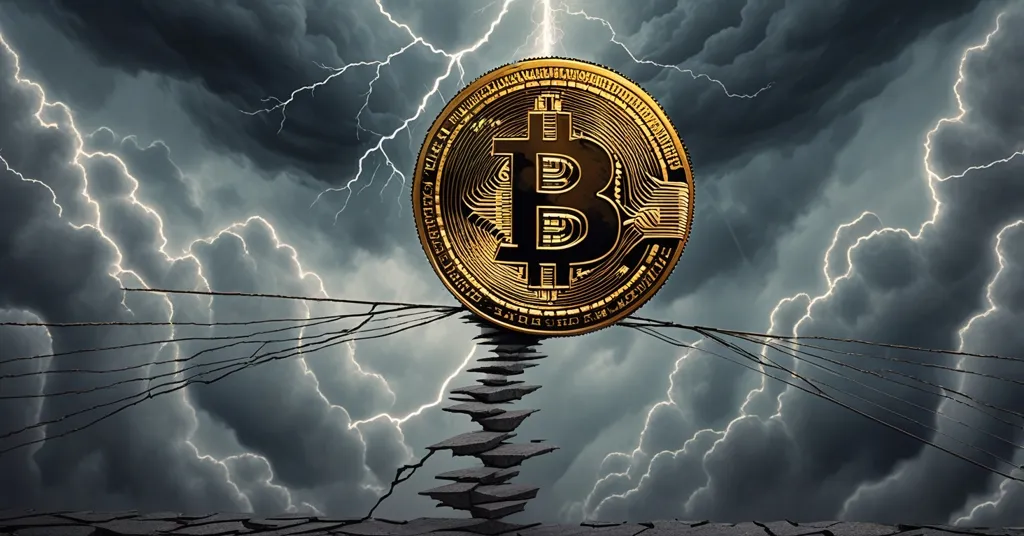Bitcoin Holds $104K Support Post-Fed Rate Pause: Breakout or Breakdown Next?

Bitcoin Clings to $104,000 Support After Fed Rate Freeze: Rally or Rug Pull Ahead?
Bitcoin (BTC) is holding its ground at the $104,000 mark, a critical support level, even as the US Federal Reserve opts to keep interest rates steady for the fourth straight meeting. While this decision initially doused hopes for risk-on assets like crypto, on-chain data and market signals are painting a mixed picture—could this be the setup for a breakout, or are we teetering on the edge of a nasty drop? Let’s unpack the numbers and cut through the noise.
- Fed’s Rate Stance: Unchanged interest rates signal caution for Bitcoin, but historical trends often point to bullish rebounds after stabilization.
- $104,000 Fortress: Strong demand absorbs selling pressure at this level, though risks of a breakdown loom if momentum falters.
- Market Dynamics: Deleveraging on Binance hints at stability, but plummeting trading volumes could stall any rally in its tracks.
Fed’s Hardball: A Double-Edged Sword for Bitcoin
The Federal Reserve’s latest decision to maintain interest rates has sent ripples through financial markets, and Bitcoin isn’t immune. Higher or steady rates often push investors toward safer bets like bonds, siphoning liquidity from speculative assets like crypto. Without the promise of a rate cut—potentially delayed until Q3 2025, according to some market watchers—risk-on sentiment takes a hit. Yet, Bitcoin’s decentralized nature has historically allowed it to defy this logic in past cycles. As CryptoQuant contributor Amr Taha points out:
Historically, BTC has shown bullish tendencies following rate stabilization, especially when paired with signs of liquidation exhaustion and fading open interest.
Looking back to 2021-2022, during the Fed’s aggressive rate hikes, Bitcoin weathered initial storms before staging recoveries as markets adapted to the new normal. Today, trading at $104,274 (up a modest 0.3% in the past 24 hours but 6.3% below its recent all-time high of $111,814), BTC shows resilience. The question is whether history will repeat or if macro headwinds will prove too strong this time. For deeper insights into how these policies impact BTC, check out this analysis of Bitcoin’s reaction to Federal Reserve decisions.
$104,000: Fortress or Fault Line?
Zooming into the price action, the $104,000 level has emerged as a battleground. On-chain data from CryptoQuant reveals a robust demand zone here, with consistent equal lows forming as selling pressure gets absorbed. It’s also acting as a liquidation magnet—a point where late long positions are getting wiped out in what’s called a long squeeze. For the uninitiated, a long squeeze happens when a sharp price dip forces over-leveraged traders betting on a rise to sell or get liquidated, often amplifying the drop temporarily. This cleanup of speculative excess can be healthy, resetting the market for more stable moves. For a detailed look at this critical price point, see this report on Bitcoin holding the $104,000 support.
But let’s not get too cozy. Some analysts warn of a potential rug pull if this support cracks, especially with tactics like order book spoofing in play—where bad actors place fake buy or sell orders to mislead others about real supply and demand, triggering sudden price shifts. If selling pressure intensifies or a coordinated dump hits, a break below $104,000 could drag BTC into bearish territory. On the flip side, CoinGlass data hints at a possible short squeeze targeting $106,000, where a rapid price spike could force short sellers to buy back BTC to cover losses, fueling an upward surge. It’s a tightrope walk—fortress today, fault line tomorrow. Community discussions on this topic can be found in this Reddit thread about the $104,000 support level.
Derivatives Data: Cleaning House on Binance
Shifting to the derivatives market, particularly on Binance, there’s a silver lining: progressive deleveraging. Open interest—the total number of outstanding long and short contracts—has been trending down with lower lows, a sign that speculative froth is being flushed out. This isn’t just background noise; it’s a step toward market maturity. When over-leveraged positions shrink, the risk of wild price swings drops, laying a foundation for sustainable growth. Think of it as clearing the deadwood before a forest can thrive.
Yet, it’s not all sunshine and rainbows. Trading volumes on major exchanges have slumped to multi-year lows—let’s not sugarcoat it, market participation is in the gutter. Bullish momentum needs fuel, and right now, the tank’s running on fumes. Without buyers stepping up, even the cleanest derivatives setup can’t ignite a rally. Stability isn’t the same as strength, and Bitcoin needs a spark to break out of this consolidation phase. Curious about the broader context of Fed policies on crypto? Explore this discussion on how Fed rate policies affect Bitcoin.
On-Chain Clues: Bullish Whispers Amid Bearish Shadows
Beneath the surface, on-chain indicators offer glimmers of hope. CryptoQuant analysis shows short-term BTC sellers losing steam, suggesting selling pressure might be nearing exhaustion. Retail euphoria—that contrarian red flag often signaling a market top—is nowhere to be seen, hinting this rally, if it kicks off, could still be in its early or mid-stage. Then there’s the Puell Multiple, a metric comparing miner revenue to historical averages to gauge if Bitcoin is over or undervalued. When miners earn less relative to past norms, it often means BTC is undervalued as their selling pressure eases. Right now, this metric screams room for growth. Dive into more on-chain insights with this CryptoQuant breakdown of the $104,000 support zone.
Adding to the bullish undertone, CryptoQuant analyst Oinonen notes a staggering 400% spike in Binance’s whale ratio metric since mid-2023 (from 0.08 to 0.77). This ratio measures how much trading activity comes from large investors (whales) versus retail players, and the surge signals heavy accumulation by big holders. Are they gearing up for a spot ETF-driven pump, or hedging for a long-term play? It’s anyone’s guess, but when whales quietly stack sats, it’s often a vote of confidence. Behaviorally, low inflows to Binance from both whales and retail also suggest a lack of panic selling—a “hold” mentality that could underpin stability. For more on this trend, check out this analysis of whale accumulation on Binance.
Still, for every bullish breadcrumb, there’s a bearish trap waiting. Beyond spoofing risks, macroeconomic surprises like stronger-than-expected inflation data or a sudden Fed pivot to rate hikes could spook markets. Technologically, a major exchange hack or regulatory crackdown could dent confidence. Even on charts, a breakdown below $104,000 might trigger bearish patterns like a death cross, where short-term moving averages slide below long-term ones, signaling potential doom. So, are we staring at the calm before a storm, or just another crypto mirage? For background on policy impacts, take a look at this overview of Federal Reserve policy and Bitcoin.
Bitcoin’s Edge and the Broader Market
Unlike many altcoins that crumble under macro pressure, Bitcoin’s battle-tested network keeps drawing in the heavy hitters. If BTC holds or breaks at $104,000, the ripple effect on altcoins like Ethereum could amplify market-wide gains or losses. While I lean toward a Bitcoin maximalist view—seeing BTC as the ultimate store of value and hedge against centralized systems—other blockchains fill niches BTC doesn’t aim to. Ethereum’s smart contracts or privacy coins like Monero play their part in this financial revolution, but Bitcoin’s unique resilience remains unmatched in times like these.
Let’s also throw in a word of caution: with trading activity this low, manipulation becomes child’s play for bad actors. Beware of shills hyping guaranteed breakouts or pumping dodgy price predictions. No one’s got a crystal ball, and in crypto, complacency is the real rug pull. Stick to the data, not the hype.
Key Questions for Bitcoin Enthusiasts
- How does the Federal Reserve’s steady rate policy impact Bitcoin’s price?
It initially curbs enthusiasm for risk-on assets like BTC by delaying monetary stimulus, but past trends show Bitcoin often rebounds as markets adjust to rate stability. - Is the $104,000 support a solid base for a Bitcoin rally?
On-chain data highlights strong demand and liquidation absorption at this level, making it a key zone, but a break below due to spoofing or heavy selling could spell trouble. - What does deleveraging on Binance mean for Bitcoin’s stability?
Shrinking speculative excess in derivatives reduces volatility risks, setting a healthier stage for potential growth if participation picks up. - Why are declining trading volumes a red flag for BTC bulls?
Low volumes signal weak market engagement, which could choke bullish momentum and prevent a sustained breakout without a major catalyst. - Can on-chain metrics like the Puell Multiple forecast Bitcoin’s next move?
Indicators like the Puell Multiple suggest room for upside, and fading seller pressure hints at an early-stage rally, though these aren’t ironclad guarantees. - What’s the significance of whale accumulation on Binance?
A 400% surge in whale activity points to big players stacking BTC, possibly signaling confidence in future gains, though their exact motives remain unclear.
Navigating Bitcoin’s current landscape feels like playing chess in a thunderstorm. The $104,000 support, deleveraging trends, and whale accumulation sketch a picture of latent strength, but dwindling trading volumes and macro uncertainties remind us that crypto doesn’t hand out easy wins. As Bitcoin battles centralized policy whims, it’s a stark reminder that true financial sovereignty isn’t just about price—it’s about outlasting the system’s games. Will BTC prove its grit with a push toward $106,000, or are we one false move from a bloodbath? Keep your wits sharp; in this market, the only sure bet is volatility.



